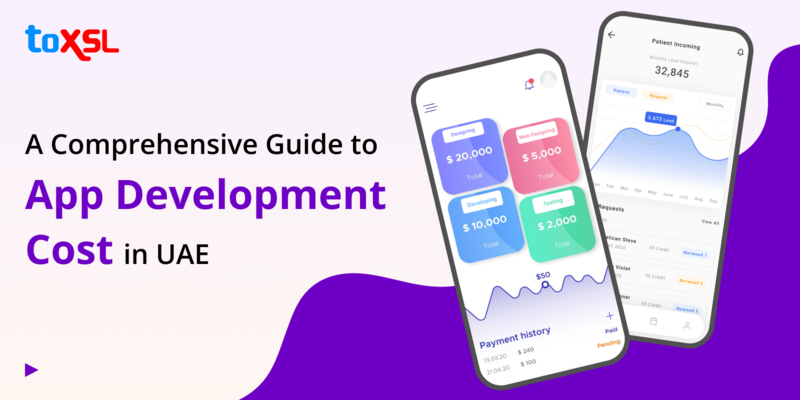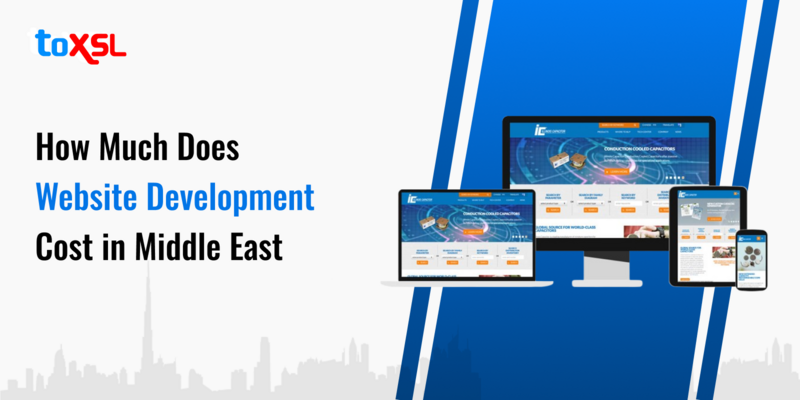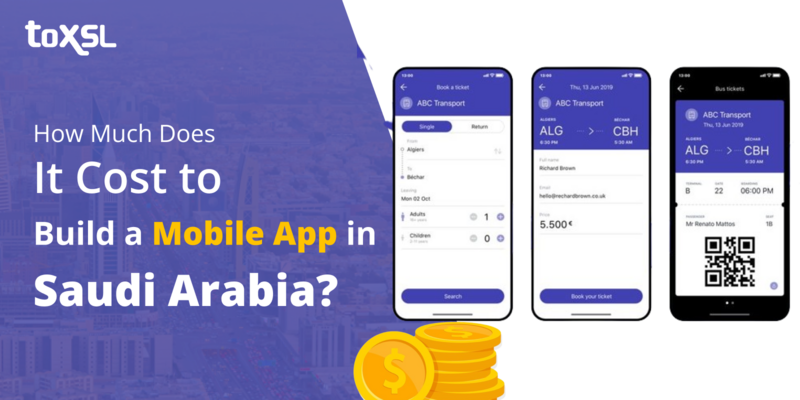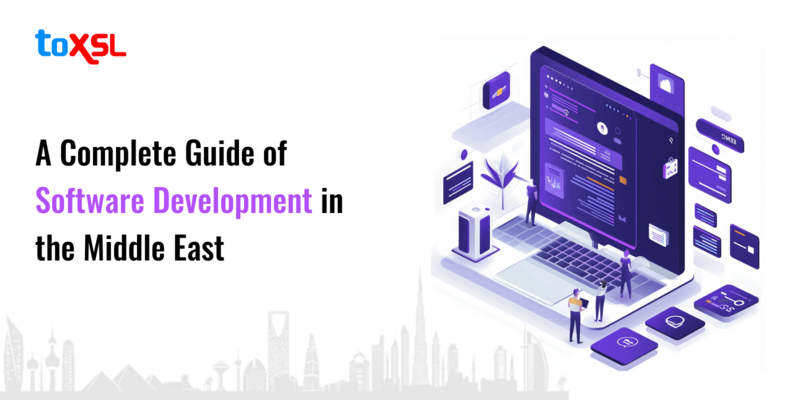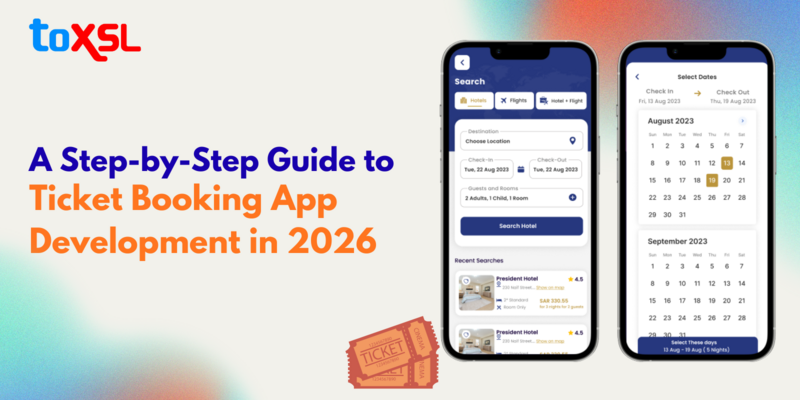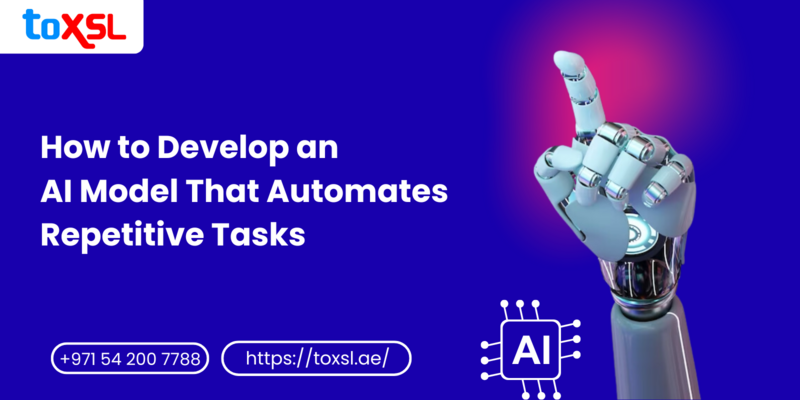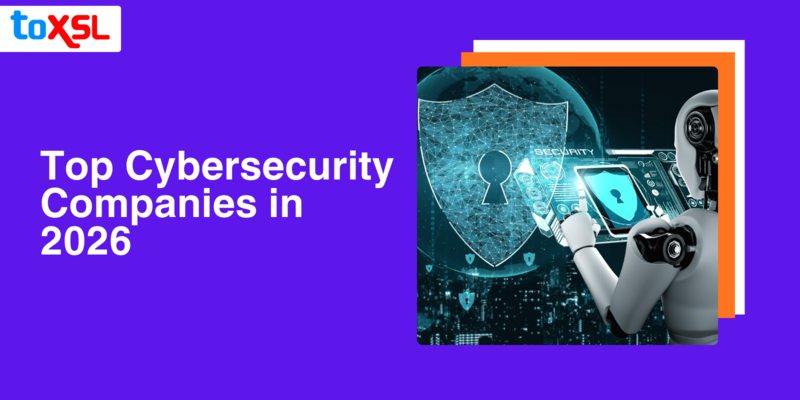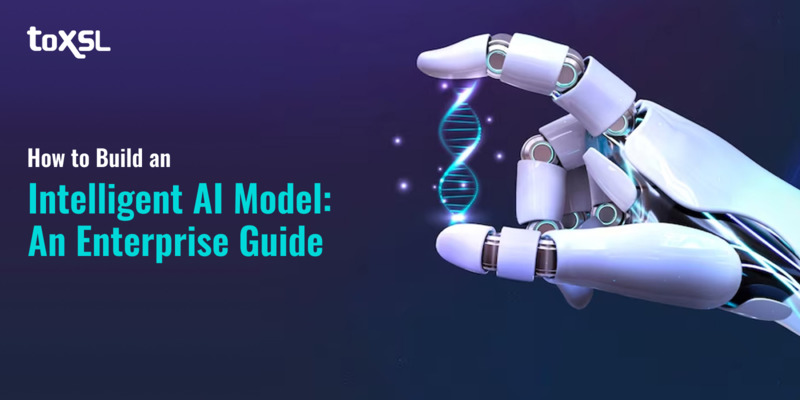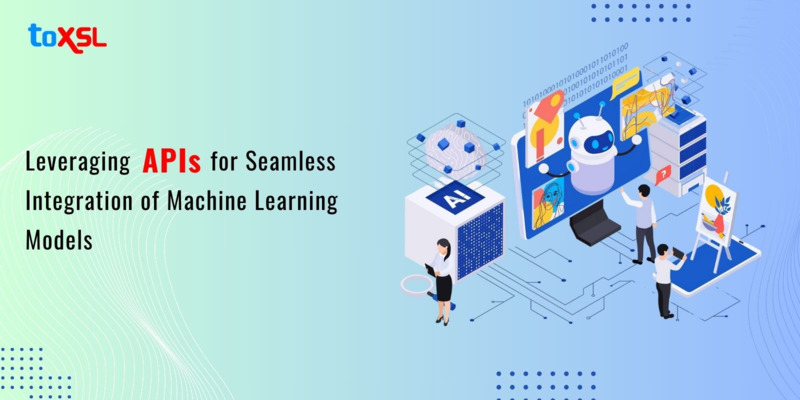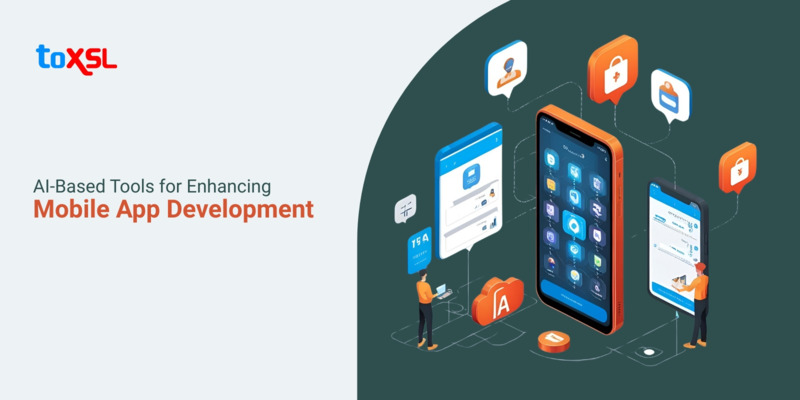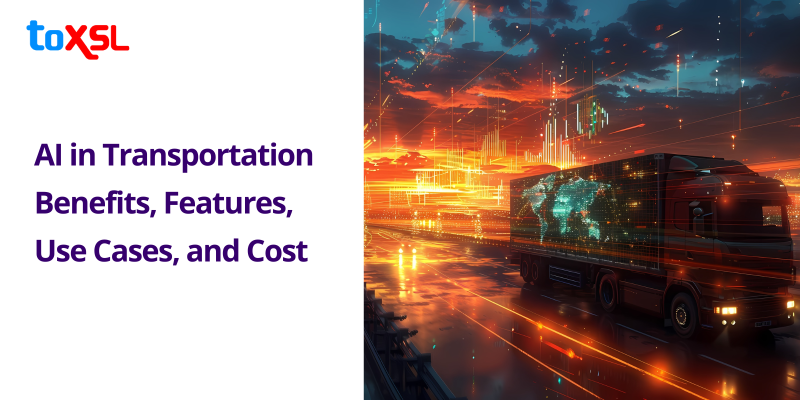
The transportation industry is undergoing a massive transformation with the integration of Artificial Intelligence (AI). From improving logistics efficiency to enhancing road safety, AI is revolutionizing the way goods and people move across the globe. At ToXSL Technologies, we specialize in developing AI-driven solutions that empower transportation companies to optimize operations, reduce costs, and deliver a better experience to their customers. This comprehensive guide explores the benefits, features, use cases, and cost considerations of AI in transportation.
According to a report, the transportation market is expected to reach US$6.3 billion by 2029. AI helps businesses monitor vehicles such as trucks or trains, and detect issues early so that businesses can fix them before they break down.
Key Takeaways
AI in transportation improves operational efficiency, safety, and predictive maintenance.
AI-powered solutions reduce fuel consumption, traffic congestion, and operational costs.
Autonomous vehicles, smart traffic management, and predictive logistics are key use cases.
Implementing AI requires careful cost analysis but delivers long-term ROI.
Introduction to AI in Transportation
Artificial Intelligence (AI) refers to the simulation of human intelligence in machines that are programmed to think, learn, and make decisions. In the transportation sector, AI applications range from route optimization and autonomous vehicles to traffic management and predictive maintenance. Companies that leverage AI in transportation gain a competitive edge by improving efficiency, reducing operational costs, and ensuring safer travel for passengers and cargo.
The global AI in transportation market is rapidly expanding due to advancements in machine learning, computer vision, and IoT technologies. At ToXSL Technologies, we develop customized AI solutions to address the unique challenges of the transportation industry.
Why AI is Crucial in Modern Transportation
Artificial Intelligence (AI) is transforming transportation into a smarter, safer, and more efficient industry. Its importance lies in the ability to process massive amounts of data, make real-time decisions, and predict outcomes that humans alone cannot achieve. AI ensures that transportation systems are not only operationally efficient but also safer, cost-effective, and environmentally sustainable.
1. Enhancing Safety and Reducing Accidents
AI improves safety by monitoring vehicle performance, driver behavior, and road conditions. Advanced computer vision and predictive algorithms can detect potential hazards, issue alerts, and even take preventive actions to avoid collisions. By reducing human error, AI contributes to safer roads and fewer accidents.
2. Optimizing Traffic and Reducing Congestion
Urban transportation faces the challenge of increasing traffic congestion. AI analyzes traffic patterns, predicts bottlenecks, and dynamically manages traffic flow. Intelligent traffic systems and AI-powered route optimization help reduce travel time, fuel consumption, and carbon emissions.
3. Supporting Autonomous and Connected Vehicles
AI is the backbone of autonomous vehicles, enabling them to perceive the environment, make decisions, and navigate safely without human intervention. Connected vehicles use AI to communicate with traffic systems, other vehicles, and infrastructure, resulting in more coordinated and efficient transportation networks.
4. Reducing Operational Costs
By implementing AI, transportation companies can minimize operational expenses. Predictive maintenance prevents costly breakdowns, optimized routing reduces fuel consumption, and automation reduces labor costs. AI delivers measurable cost savings while increasing the reliability of transportation services.
5. Improving Customer Experience
AI in transportation enhances customer experience through real-time tracking, accurate arrival predictions, and personalized services. Passengers and logistics clients receive timely updates, reliable schedules, and efficient delivery, increasing satisfaction and trust in transportation providers.
Benefits of AI in Transportation
1. Enhanced Operational Efficiency
AI improves operational efficiency by automating complex processes in transportation. This includes optimizing fleet management, reducing idle time, and streamlining delivery schedules. AI algorithms analyze historical and real-time data to determine the most efficient routes, helping transportation companies save both time and money.
- Fleet Optimization: AI-powered fleet management systems track vehicle performance, fuel usage, and driver behavior, ensuring maximum efficiency.
- Route Planning: Advanced AI models calculate optimal routes based on traffic, weather, and road conditions, reducing delays and fuel consumption.
- Load Optimization: AI helps in determining the most efficient way to load cargo, minimizing transportation costs and increasing vehicle utilization.
2. Improved Safety and Risk Management
AI enhances transportation safety by predicting and mitigating potential risks. By leveraging machine learning and computer vision, transportation systems can detect anomalies, monitor driver behavior, and prevent accidents.
- Driver Assistance: AI-based systems provide real-time alerts to drivers about potential hazards, lane departures, and collisions.
- Predictive Maintenance: AI predicts vehicle component failures before they occur, reducing breakdowns and ensuring safer operations.
- Traffic Safety: AI-powered traffic monitoring systems can detect dangerous driving patterns and alert authorities, reducing road accidents.
3. Reduced Operational Costs
One of the most significant benefits of AI in transportation is cost reduction. By optimizing routes, improving fuel efficiency, and reducing downtime through predictive maintenance, companies can save substantial operational expenses.
- Fuel Optimization: AI algorithms analyze driving patterns and suggest fuel-efficient routes and driving behavior.
- Maintenance Cost Reduction: Predictive maintenance ensures vehicles are serviced only when needed, avoiding unnecessary expenditures.
- Labor Efficiency: AI automates repetitive tasks, allowing staff to focus on higher-value activities, reducing labor costs.
4. Enhanced Customer Experience
AI in transportation improves customer experience by providing real-time tracking, predictive delivery times, and personalized services.
- Real-Time Tracking: Customers can monitor the location of their shipments or public transportation in real-time.
- Predictive Arrival Times: AI models predict accurate delivery or arrival times based on traffic and route conditions.
- Personalized Services: AI can recommend preferred routes or services to customers based on their behavior and preferences.
Key Features of AI in Transportation
AI-powered transportation systems come with several advanced features that enhance operational efficiency and safety.
1. Autonomous Vehicles
Autonomous vehicles are one of the most groundbreaking applications of AI in transportation. Self-driving cars, trucks, and buses leverage AI to navigate roads safely without human intervention.
- Sensors and Computer Vision: AI uses cameras, LiDAR, and radar sensors to perceive the environment.
- Decision-Making Algorithms: AI algorithms analyze real-time data to make driving decisions, such as braking, lane changing, and route selection.
- Safety Features: AI ensures collision avoidance, pedestrian detection, and adaptive cruise control, making autonomous vehicles safer than traditional ones.
2. Intelligent Traffic Management
AI helps manage traffic flow efficiently, reducing congestion and improving city mobility.
- Predictive Analytics: AI predicts traffic patterns and adjusts traffic lights in real-time to avoid jams.
- Smart Parking Solutions: AI identifies available parking spots, reducing time spent searching for parking.
- Emergency Management: AI systems prioritize emergency vehicles and manage rerouting during accidents or roadblocks.
3. Predictive Maintenance
Predictive maintenance is a critical feature of AI in transportation that reduces vehicle downtime and maintenance costs.
- Sensor Monitoring: AI monitors engine performance, brake systems, and other critical components.
- Failure Prediction: Machine learning models analyze historical and real-time data to forecast potential failures.
- Maintenance Scheduling: AI helps schedule timely maintenance, minimizing disruptions to operations.
4. Route Optimization and Logistics Planning
AI optimizes routes and improves logistics planning for transportation companies.
- Dynamic Routing: AI algorithms adjust routes in real-time based on traffic, weather, and road conditions.
- Load Planning: AI ensures maximum load capacity utilization, reducing the number of trips and fuel consumption.
- Delivery Scheduling: AI predicts optimal delivery times, improving efficiency and customer satisfaction.
5. Driver Assistance Systems
AI-powered driver assistance systems help drivers operate vehicles safely and efficiently.
- Collision Avoidance: AI detects potential collisions and alerts drivers or takes corrective action.
- Adaptive Cruise Control: AI adjusts vehicle speed based on traffic conditions.
- Lane Keeping Assistance: AI ensures vehicles stay within their lanes, reducing accidents caused by driver errors.
Use Cases of AI in Transportation
AI is transforming multiple facets of transportation, from public transit to logistics and autonomous vehicles.
1. Autonomous Trucks and Delivery Vehicles
AI-powered autonomous trucks and delivery vehicles are revolutionizing logistics and supply chain management.
24/7 Operations: Autonomous vehicles can operate around the clock, reducing delivery times.
Reduced Human Error: AI minimizes accidents caused by driver fatigue or error.
Cost Efficiency: Autonomous vehicles reduce labor costs and improve fuel efficiency.
2. Public Transportation Optimization
AI is improving the efficiency and safety of public transportation systems.
Bus and Train Scheduling: AI predicts passenger demand and adjusts schedules accordingly.
Real-Time Monitoring: AI tracks vehicle locations and delays, providing real-time updates to commuters.
Traffic Flow Management: AI reduces congestion and improves the overall reliability of public transit.
3. Smart Cities and Traffic Management
AI plays a crucial role in building smart cities with optimized traffic flow.
Traffic Prediction: AI forecasts traffic volumes and suggests alternate routes.
Accident Detection: AI monitors roads for accidents and triggers emergency response.
Emission Reduction: Optimized traffic flow reduces fuel consumption and pollution.
4. Predictive Maintenance in Fleet Management
AI helps fleet managers predict vehicle issues before they occur, minimizing downtime.
Data-Driven Insights: AI analyzes engine and sensor data to predict component failures.
Reduced Maintenance Costs: Predictive maintenance avoids expensive repairs and extends vehicle lifespan.
Improved Reliability: Ensures that vehicles are always in optimal working condition.
5. Logistics and Supply Chain Optimization
AI is transforming logistics operations by optimizing routes, inventory, and delivery schedules.
Route Optimization: AI minimizes delivery times and reduces fuel consumption.
Inventory Management: AI predicts demand and manages warehouse stock efficiently.
Customer Satisfaction: AI ensures timely deliveries and reduces errors in logistics operations.
Cost of Implementing AI in Transportation
Implementing Artificial Intelligence (AI) in transportation offers significant benefits, but it also requires careful planning and investment. The overall cost of AI deployment depends on multiple factors, including the type of AI technology, the scale of implementation, the complexity of transportation operations, and the level of integration required with existing systems. While the initial investment may seem high, the long-term savings, efficiency improvements, and competitive advantages make it a worthwhile endeavor.
1. Software Development and AI Solution Costs
Developing AI-powered software is one of the largest components of implementation cost. This includes creating custom algorithms, predictive models, and AI frameworks tailored to the specific needs of transportation companies.
- Custom AI Algorithms: Transportation companies often require AI solutions for route optimization, predictive maintenance, autonomous driving, and traffic management. Developing these algorithms requires specialized expertise in machine learning, data analytics, and computer vision.
- Integration with Existing Systems: AI must be seamlessly integrated with current transportation management systems, fleet tracking software, and IoT devices. Integration ensures data flows smoothly and AI-driven insights can be acted upon in real time.
- User Interface and Experience Design: AI software should include intuitive dashboards, reporting tools, and mobile interfaces that allow staff to interact with the system efficiently. User-friendly design is crucial to maximize adoption and operational benefits.
- Estimated cost: $50,000 to $500,000 depending on complexity and scale of the solution.
2. Hardware Costs
Hardware plays a critical role in AI deployment, particularly for autonomous vehicles, fleet monitoring, and IoT-enabled transportation systems.
- Sensors and Cameras: Autonomous vehicles and AI-powered systems rely on cameras, LiDAR, radar, and ultrasonic sensors to perceive their environment accurately. These sensors are essential for safe navigation and decision-making.
- Edge Computing Devices: AI algorithms often require real-time processing on vehicles or at network edges. Specialized computing devices ensure that large volumes of data are processed without delays.
- IoT Devices and Connectivity: Fleet tracking, predictive maintenance, and traffic monitoring require IoT devices, GPS trackers, and communication systems. Reliable connectivity ensures seamless data transmission for AI decision-making.
- Estimated cost: $20,000 to $200,000 per vehicle or system deployment depending on technology and scale.
3. Data Management and Maintenance Costs
AI thrives on data, and managing this data effectively is crucial for accurate predictions and reliable operations.
- Data Collection and Storage: Collecting real-time vehicle telemetry, traffic information, and sensor data generates large volumes of data. Storing this data securely and efficiently is a significant cost consideration.
- Data Processing and Analysis: AI models require processing power to analyze data and generate actionable insights. This includes maintaining servers, cloud services, and computing resources.
- Ongoing Maintenance and Updates: AI systems require regular updates to algorithms, security patches, and software upgrades to remain effective and compliant with evolving transportation regulations.
- Estimated annual cost: 10–20% of the initial implementation cost, depending on data volume and system complexity.
4. Training and Workforce Costs
Implementing AI in transportation also involves training employees to work with AI-powered systems effectively.
- Driver and Operator Training: Drivers and fleet operators need guidance on how to use AI-assisted navigation, monitoring, and safety systems.
- Technical Staff Training: IT teams and system administrators require training on AI system maintenance, troubleshooting, and updates.
- Change Management: Ensuring a smooth transition to AI-driven processes often involves workshops, demonstrations, and ongoing support.
- Estimated cost: Variable, depending on the size of the workforce and the complexity of AI adoption.
5. Return on Investment (ROI)
Although the initial costs of AI implementation can be substantial, the long-term benefits often outweigh the investment.
- Fuel and Energy Savings: Optimized routes and AI-assisted driving can reduce fuel consumption significantly.
- Reduced Maintenance Costs: Predictive maintenance prevents expensive vehicle breakdowns and extends the lifespan of fleet assets.
- Improved Efficiency and Productivity: Automation of repetitive tasks, better route planning, and real-time insights boost operational efficiency.
- Enhanced Safety and Reduced Liability: Fewer accidents, improved monitoring, and proactive safety measures reduce insurance costs and potential legal liabilities.
When calculated over time, AI implementation provides a measurable return on investment by reducing operational expenses, improving customer satisfaction, and enhancing competitive advantage in the transportation industry.
Future of AI in Transportation
The future of AI in transportation is highly promising. Emerging technologies such as autonomous flying vehicles, hyperloop systems, and AI-driven traffic management will further revolutionize mobility. AI will also enable more sustainable transportation solutions by optimizing energy consumption and reducing emissions.
At ToXSL Technologies, we stay ahead of trends and develop innovative AI solutions that help transportation companies adapt to future challenges while maximizing efficiency, safety, and profitability.
Conclusion
AI in transportation is no longer a futuristic concept but a practical solution that is transforming the industry. From autonomous vehicles and intelligent traffic management to predictive maintenance and logistics optimization, AI is driving operational efficiency, safety, and cost reduction. While implementation costs may vary, the long-term benefits far outweigh the initial investment.
At ToXSL Technologies, we specialize in building customized AI solutions for the transportation sector. Our expertise enables businesses to leverage AI effectively, enhance operational performance, and deliver a superior customer experience. Contact us today to explore how AI can revolutionize your transportation operations.
FAQ's
1. How does AI improve safety in transportation?
AI enhances safety by monitoring driver behavior, vehicle performance, and traffic conditions in real-time. Predictive analytics detect potential hazards, prevent collisions, and enable timely alerts, significantly reducing accidents and ensuring safer transportation for passengers and cargo.
2. How does AI enhance customer experience in transportation?
AI improves customer experience by providing real-time tracking, accurate delivery predictions, and personalized services. Passengers and logistics clients benefit from timely updates, reliable schedules, and optimized transportation services.
3. What are the key benefits of AI-powered route optimization?
AI-powered route optimization reduces travel time, fuel consumption, and operational costs. By analyzing traffic, weather, and road conditions, AI ensures the most efficient routes are selected, improving delivery accuracy and overall fleet performance.
4. How does AI integrate with IoT in transportation?
AI leverages IoT devices to collect real-time data from vehicles, traffic systems, and infrastructure. This data is analyzed to optimize routes, schedule maintenance, and monitor fleet performance, enhancing operational efficiency and decision-making.
5. How do companies measure the ROI of AI in transportation?
ROI is measured through reduced operational costs, lower fuel consumption, minimized maintenance expenses, improved delivery times, and enhanced customer satisfaction. Companies calculate savings versus investment to evaluate AI’s long-term benefits.

